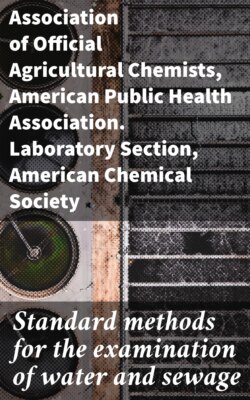Читать книгу Standard methods for the examination of water and sewage - Association of Official Agricultural Chemists - Страница 9
TURBIDITY STANDARD.[110]
ОглавлениеThe standard of turbidity shall be that adopted by the United States Geological Survey, namely, a water which contains 100 parts per million of silica in such a state of fineness that a bright platinum wire 1 millimeter in diameter can just be seen when the center of the wire is 100 millimeters below the surface of the water and the eye of the observer is 1.2 meters above the wire, the observation being made in the middle of the day, in the open air, but not in sunlight, and in a vessel so large that the sides do not shut out the light so as to influence the results. The turbidity of such water is arbitrarily fixed at 100 parts per million.
For preparation of the silica standard dry Pear’s “precipitated fuller’s earth” and sift it through a 200–mesh sieve. One gram of this preparation in 1 liter of distilled water makes a stock suspension which contains 1,000 parts per million of silica and which should have a turbidity of 1,000. Test this suspension, after diluting a portion of it with nine times its volume of distilled water, by the platinum wire method to ascertain if the silica has the necessary degree of fineness and if the suspension has the necessary degree of turbidity. If not, correct by adding more silica or more water as the case demands.[A]
A. This method of correction very slightly alters the coefficient of fineness of the standard, but does not noticeably affect its use.
Standards for comparison shall be prepared from this stock suspension by dilution with distilled water. For turbidity readings below 20, standards of 0, 5, 10, 15, and 20 shall be kept in clear glass bottles of the same size as that containing the sample; for readings above 20, standards of 20, 30, 40, 50, 60, 70, 80, 90, and 100 shall be kept in 100 cc. Nessler tubes approximately 20 millimeters in diameter.
Comparison with the standards shall be made by viewing both standard and sample sidewise toward the light by looking at some object and noting the distinctness with which the margins of the object can be seen.
The standards shall be kept stoppered, and both sample and standards shall be thoroughly shaken before making the comparison.
In order to prevent any bacterial or algal growths from developing in the standards a small amount of mercury bichloride may be added to them.
